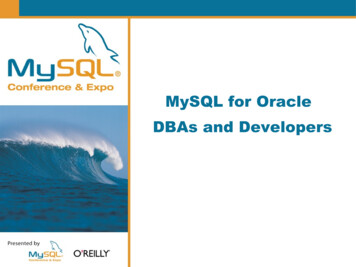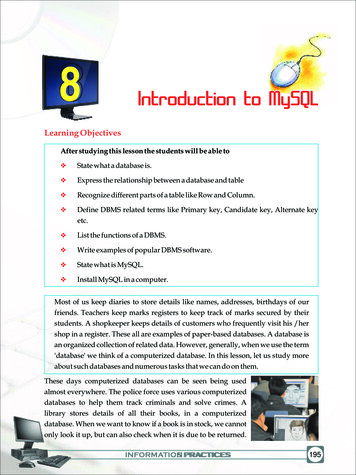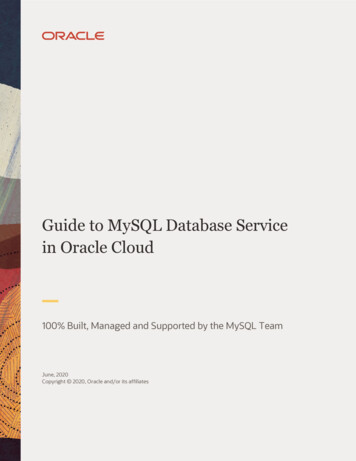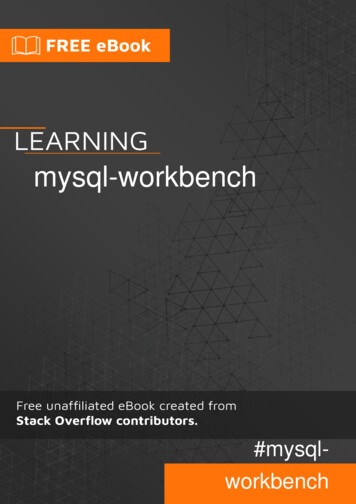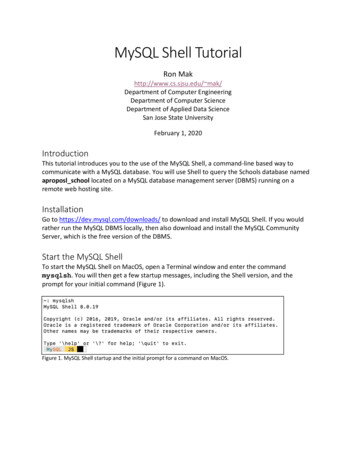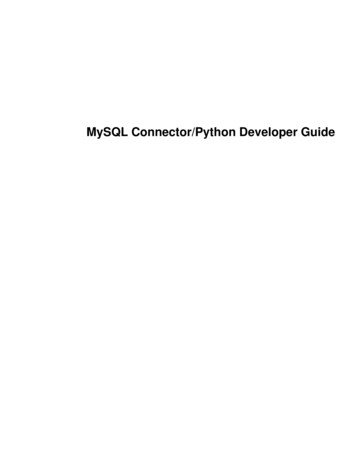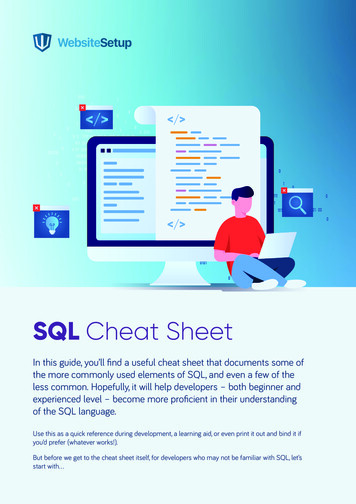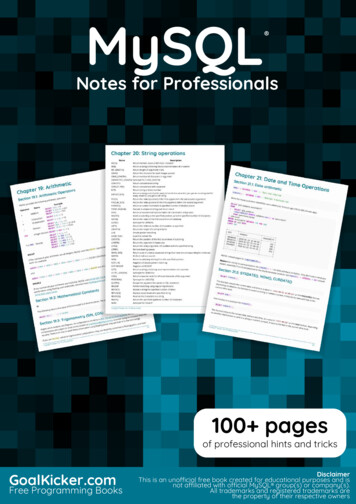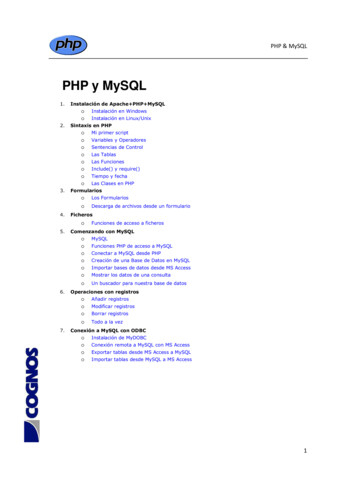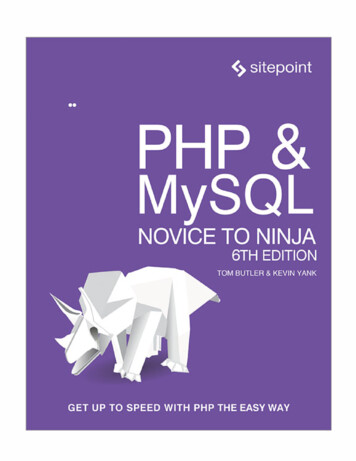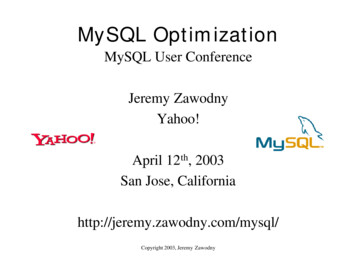
Transcription
MySQL OptimizationMySQL User ConferenceJeremy ZawodnyYahoo!April 12th, 2003San Jose, t 2003, Jeremy Zawodny
About Me Engineer in Y! Search (prev. Y! Finance)MySQL user for over 5 yearsActive in MySQL communityWrite about LAMP for Linux MagazineMySQL advocacy & support at Yahoo!Home: Jeremy@Zawodny.comWork: ql/Copyright 2003, Jeremy Zawodny
Outline IntroductionWhy Optimize?GoalsDatabase DesignApplication DesignWriting Fast QueriesMySQL Server TuningOperating System TuningHardware TuningNetwork & ReplicationWhere to Learn MoreQuestions and AnswersCopyright 2003, Jeremy Zawodny
Starting Questions What version of MySQL are you using?What languages are being used?Which operating systems?Familiarity with other RDBMS servers?Role? DBA? Developer? SysAdmin?MySQL dedicated or shared servers?How fast is your growth?– Transaction rates– Data volumeCopyright 2003, Jeremy Zawodny
What you Need to Know You should ask questions at any time– There should be sufficient time MySQL usage– Basic queries (SELECT, UPDATE, INSERT)– Installation or where files are located Basic programming concepts– Any language will do Operating system basics– Memory usage, swapping, etc.Copyright 2003, Jeremy Zawodny
MySQL at Yahoo! Roughly 200-400 servers world-wideFreeBSD and LinuxCommodity hardwareReplaces home-grown “database” systemsReplaces Oracle in a few casesTypical install uses between 1-20GBUsed both “live” and in batch processingReplication and load-balancingCopyright 2003, Jeremy Zawodny
Why Optimize? You can do more with less– MySQL on “normal” hardware scales well– A little time can save thousands in hardware– The classic story goes As you data grows, you’ll need to– Performance will degrade over time– You’re probably not monitoring it anyway It is easier than re-coding you apps Your users will notice if you don’t!Copyright 2003, Jeremy Zawodny
MySQL’s Defaults Tuned for small and medium data setsUses very little memory even if availableSuitable for use in a shared environmentAssumes little about your hardwareBegins to slow as growth continuesUses non-transactional tables (MyISAM)– That’s what most people need (90%)– Very low overheadCopyright 2003, Jeremy Zawodny
Scaling MySQL Like Linux, MySQL scales up and downCan run many MySQL instances at onceCan run one very big MySQL instanceCan run with only a few MB of memory– Suitable for small devices– Will be disk-bound Can embed using libmysqld (MySQL 4.x) Can recompile to add/remove features– Table types, query cache, etc.Copyright 2003, Jeremy Zawodny
Using Less Hardware Hardware is rarely the bottleneck– Well-tuned servers are often disk-bound MySQL isn’t using it aggressively– You must configure it Modern CPUs are very fast– What you have is probably sufficient Memory is plentiful– You’re probably not using what you have Upgrades do little to solve most problems!Copyright 2003, Jeremy Zawodny
Goals Learn to write fast queries and applicationsLearn to design and use the right tablesKnow where to look for bottlenecksPredict behavior as load increasesUnderstand what to monitor over timeUnderstand how MySQL uses system resourcesLearn what settings you can adjust– In your operating system– In MySQL– In your applications Know where to learn more Copyright 2003, Jeremy Zawodny
Database Design Normalize your data by default– Sometime you need to de-normalize– When in doubt, benchmark MySQL super-smackMySQL benchmark suiteHome-grown toolsUse your real apps!Copyright 2003, Jeremy Zawodny
Database Design Select the right column types––––No bigger than you needMySQL provides a ton of column typesUse NOT NULL where it makes senseUse fixed column sizes if you can MyISAM tables with fixed rows are faster Concurrency improvements– Store compressed data when possibleSee: http://www.mysql.com/doc/S/t/Storage requirements.htmlCopyright 2003, Jeremy Zawodny
Database Design Select the right table types– What locking model do you need? Table (MyISAM) Row (InnoDB) Page (BDB)–––––Consider ratio of reads to writesForeign key constraints?Do you need transactions?Can you afford to lose records in a crash?Do you know MySQL’s table types?Copyright 2003, Jeremy Zawodny
Database Design MyISAM Tables––––––Very efficientCompact storageIn-memory key cache for index dataTable lockingNo transactionsGood for High volume logging (write) High volume reads Not both– Variations: Compressed, RAID, MergeCopyright 2003, Jeremy Zawodny
Database Design Compressed MyISAM Tables– Read-only– Good for CD-ROMs and archives MyISAM RAID Tables– Break the 2GB/4GB/whatever barrier MyISAM Merge Tables– Many physically identical MyISAM tables– Can treat as a single table (or not)Copyright 2003, Jeremy Zawodny
Database Design HEAP Tables– Stored in memory They will vanish at server shutdown– Very fast hash-based lookups Limited index use Range queries are slower––––B-Tree available in 4.1Table lockingGreat for static lookupsSize can be limited to prevent disasterCopyright 2003, Jeremy Zawodny
Database Design BDB Tables––––TransactionalAutomatic recoveryTables grow as neededPage-level locking (8KB page) Single READ-COMMITTED isolation level––––Uses Berkeley DB under the hoodFew users actually use BDBWorks well for small - medium transaction rateLocking on the last page can be a problemCopyright 2003, Jeremy Zawodny
Database Design InnoDB Tables– Modeled after Oracle Row-level locking Non-locking SELECTs Uses pre-allocated tablespace files– Multiple isolation levels Easily changed with a SET command––––Referential integrity - foreign keysHigh performanceVery high concurrencyAutomatic recovery after crashCopyright 2003, Jeremy Zawodny
Database Design Use Indexes wisely– Don’t use several indexes when one will do– Understand the “leftmost prefix” rule Index on (col1, col2, col3) vs. 3 indexes––––Don’t index columns until you need toVerify that indexes are used (difficult)Use partial indexes on large (text) fieldsIndex a hash rather than a large value (URL) MD5 is an excellent choice It’s even built-inCopyright 2003, Jeremy Zawodny
Database Design Use full-text indexing if you need it–––––MyISAM tables onlyVery fastExcellent in MySQL 4.xResults are ranked (like a search engine might)Boolean queries Flexible Mostly feature-complete– Works on any textual data Other character sets will need 4.1 or 5.0Copyright 2003, Jeremy Zawodny
Full-Text Search Use 4.0 if possible– Indexing is much faster– Stop word list customization– Min word size easily changed Remember to rebuild indexes after changing In 5.0 we should see––––Per-table stop word listsPer-table word length optionsPer-table word characters listsThese might be per-index!Copyright 2003, Jeremy Zawodny
Application Design Don’t store data you don’t need– Compress it– Get rid of it Don’t store computable data– MySQL can do it– Your app can do it Don’t ask for data you don’t need – Do you really need all fields?SELECT * FROM Copyright 2003, Jeremy Zawodny
Application Design Use MySQL extensions for speed––––REPLACE queriesBundled INSERT queriesMulti-table deletesUser variables Use logging to track bottlenecks Don’t perform unnecessary queries– Cache data (static lookup tables)– Use the Query Cache if you must Benchmark your application– Know where the bottlenecks are– Know how a slow db affects your applicationCopyright 2003, Jeremy Zawodny
Application Design Use transactions– Prevents data loss– Server does less random I/O– Performance and reliability Keep the clients “near” the server––––Network latency is a killerReplication can solve geography problemsCan also help solve geology problems (quake)Running app and MySQL on same hardwareCopyright 2003, Jeremy Zawodny
Application Design Think about growth– There are size limits that you might hit– InnoDB and MyISAM both have them (sort of) Keep primary keys short for InnoDBCopyright 2003, Jeremy Zawodny
Application Design Use prepared queries and placeholders–––––MySQL doesn’t yet support themYour API mayWhen MySQL does, you benefit!The API may be more efficient anywayMySQL 4.1 and PHP 5.0 benefitSELECT name, address, state, zipFROM customersWHERE id ?Copyright 2003, Jeremy Zawodny
Application Design Web apps– Use (but don’t over-use) connection pooling– Use middleware to abstract the database May also provide caching and pooling– Don’t keep everything in the database! Images can live on the file system But you might want to replicate them– Pick the fastest driver you can Java has several, Perl has two On Windows, use the “most native”Copyright 2003, Jeremy Zawodny
Break!Copyright 2003, Jeremy Zawodny
Writing Fast Queries Use IndexesUse EXPLAIN SELECTSimplify where clauseWatch Slow query logBundle INSERTsUNIONsCopyright 2003, Jeremy Zawodny
Writing Fast Queries Understanding how MySQL runs queries You need to think like MySQL does Some of its goals are ––––––Eliminate as many rows as possibleUse indexes where possibleAvoid table scansConsider many join ordersAvoid hitting the diskAvoid using the data records if the index has itCopyright 2003, Jeremy Zawodny
Writing Fast Queries EXPLAIN SELECT––––Tells you what MySQL is thinkingWhich keys (indexes) can it useWhich keys will it useHow many rows must it examine (roughly) ANALYZE TABLE can help– How hard must MySQL work?Copyright 2003, Jeremy Zawodny
Writing Fast Queries EXPLAIN SELECTmysql EXPLAIN SELECT * FROM Headlines H, S2H S WHERE S.Symbol 'YHOO' and H.Id S.HeadlineId; ------- -------- ------------------- --------- --------- -------------- ------ ------------------------- table type possible keys key key len ref rows Extra ------- -------- ------------------- --------- --------- -------------- ------ ------------------------- S ref HeadlineId,Symbol Symbol H eq ref PRIMARY PRIMARY 75 const 4 S.HeadlineId 383 where used; Using index 1 where used ------- -------- ------------------- --------- --------- -------------- ------ ------------------------- 2 rows in set (0.00 sec)mysql EXPLAIN SELECT * FROM Headlines H, S2H S WHERE S.Symbol 'YHOO' and H.Id S.HeadlineId ORDER BY Time DESC; ------- -------- ------------------- --------- --------- -------------- ------ ----------------------------------------- table type possible keys key key len ref rows Extra ------- -------- ------------------- --------- --------- -------------- ------ ----------------------------------------- S ref HeadlineId,Symbol Symbol H eq ref PRIMARY PRIMARY 75 const 4 S.HeadlineId 383 where used; Using index; Using temporary;Using filesort1 where used ------- -------- ------------------- --------- --------- -------------- ------ ----------------------------------------- Copyright 2003, Jeremy Zawodny
Writing Fast Queries EXPLAIN SELECT– Table Order is significant Aliases appear– Type System– Table has one row– Easily optimized Const– Only a single row matches– Read onceCopyright 2003, Jeremy Zawodny
Writing Fast Queries EXPLAIN SELECT (continued)– Type (continued) eq ref– One row matches per combination– Unique index match ref– Several matching rows per combination– Non-unique index range– A range of rows will be retrieved index– Index will be scanned for matches– Like a table scan, but faster all– Full table scan– Worst caseCopyright 2003, Jeremy Zawodny
Writing Fast Queries EXPLAIN SELECT (continued)– Possible keys What MySQL had to choose from– Key What it decided to use– Key length Length (in bytes) of the longest key– Ref Which column it will match with– Rows Approximately how many rows must be examinedCopyright 2003, Jeremy Zawodny
Writing Fast Queries EXPLAIN SELECT (continued)– Extra information Using filesort– An extra pass is required to sort the records– This can be slow at times Using index– Data will come from the index rather than rows– This can speed things up Using temporary– MySQL will create a temporary table– It’ll be a disk-based table if it’s too large Where used– The where clause will be applied to this tableCopyright 2003, Jeremy Zawodny
Writing Fast Queries Optimizer tips and tricks– It’s smart, but not perfect– Only one index per table per query You may need to de-normalize to get performance You may need to write two queries instead of one– Don’t compute in the WHERE MySQL doesn’t know how to optimize constantexpressionsSELECT * FROM HeadlinesWHERE Time SUBDATE(NOW(), INTERVAL 7 DAY);Copyright 2003, Jeremy Zawodny
Insert Speed In 4.1 and beyond, use prepared statements In older versions– Single inserts are the slowest– Multi-rows inserts are faster– Bulk-loading (LOAD DATA or mysqlimport)are very, very, very fast Using InnoDB, use transactions wisely– Many inserts in AUTOCOMMIT mode arevery, very slowCopyright 2003, Jeremy Zawodny
Query Cache Part of MySQL 4.0Can seriously boost performanceMight save legacy apps you can’t changeUse query cache selectively if you have lotsof writes– SELECT SQL CACHE Use mytop to watch query cache stats– Version 1.3 and 1.4 will have more statsCopyright 2003, Jeremy Zawodny
MySQL Server Tuning Watching performance Benchmarking Tunable Parameters– Most bang, least effort– Incremental gains Methodology– Iterative testing– Long-term monitoringCopyright 2003, Jeremy Zawodny
MySQL Server TuningWatching PerformanceCopyright 2003, Jeremy Zawodny
MySQL Server Tuning Key Performance Numbers– Queries per second Min, Max, Short-term, Long-Term– Bytes per second Inbound vs. Outbound– New connections per second– Idle vs. Active clients– Key cache efficiency– Query cache efficiencyCopyright 2003, Jeremy Zawodny
MySQL Server Tuning How MySQL uses memory– Main Global Caches and Buffers Query cacheKey bufferTable cacheInnoDB buffer poolInnoDB log buffer– Main Thread-specific Caches and Buffers Record buffer Sort buffer Join bufferCopyright 2003, Jeremy Zawodny
MySQL Server Tuning SHOW STAUTS– Created tmp disk tables If large, increase temp table size– Handler * Determine key buffer effectiveness– Com * Find the commands that are most often run– Questions and Uptime Compute queries/second– Select * How many types of each SELECT are executed– Qcache * Query cache performanceCopyright 2003, Jeremy Zawodny
On-the-Fly Tuning Use MySQL’s SET syntax to changeparameters on the fly (new in 4.0)–––––max connectionswait timeoutthread cachekey buffer sizetable cache Don’t change too much at once Persistent connections aren’t always fast! Changes may take time to noticeCopyright 2003, Jeremy Zawodny
MySQL Server Tuning SHOW STATUS– Table locks * How many times are queries waiting for locks? Concurrency problems show up here– Bytes * How much data are you pumping out Compare with inbound traffic– Qcache * Query cache performance Memory usageCopyright 2003, Jeremy Zawodny
MySQL Server Tuning my.cnf file parameters–––––––key buffertmp table sizeTable cacheMax connectionsMax user connectionsLong query timeThread concurrencyCopyright 2003, Jeremy Zawodny
MySQL Server Tuning my.cnf file parameters––––––innodb buffer pool sizeinnodb log file sizeinnodb file io threadsinnodb flush log at trx commitinnodb log buffer sizeinnodb flush method fdatasync O DSYNCCopyright 2003, Jeremy Zawodny
InnoDB Performance Transaction log flushing has three options– (1) Flush on commit– (0) Never flush– (2) Flush once per secondCopyright 2003, Jeremy Zawodny
MySQL Server Tuning Fileysystem Issues– Spread data among disks Put heavily used and lightly used databases togetherRAID-5 or RAID-10 for data (w/batter-backed cache)RAID-1 for logsNew CREATE TABLE makes this easier– Logs separate from data Logs are mostly serialized writes Tables are updated and used in mostly random fashion– If you have a lot of tables in a database Use a filesystem designed to handle it ResiserFS is a good choice– A journaling filesystem Makes crash recovery faster Better utilizes disk I/O (usually)Copyright 2003, Jeremy Zawodny
MySQL Server Tuning Upgrade once in a while– New versions are often faster– Better optimizations in query parser– New and enhanced caching Convert older tables to newer format– ISAM to MyISAM– BDB to InnoDB (or not)– ALTER TABLE my table TYPE InnoDB Don’t flush the transaction logs on commitCopyright 2003, Jeremy Zawodny
Upgrade Testing It’s often a good idea to keep up-to-date Performance tweaks and optimizations areintroduced during the maintenance process Be sure to test your critical queries carefully Always use a real load test or read theEXPLAIN output Without load, “slow” queries are often fastCopyright 2003, Jeremy Zawodny
Operating System Tuning Virtual Memory Use– FreeBSD - excellent– Linux - varies wildly 2.4.9 good 2.4.16 good Others not good Per-process limits on:– Memory– File descriptors Network duplex settings Competing processes on the machine?Copyright 2003, Jeremy Zawodny
Operating System Tuning Key Metrics– Memory used/free/cache/buffer Swapping is very bad You might even disable swap– Paging and page faults Make sure there’s no memory pressure Server variables might be wrong if many page faults– Disk I/O Make sure the I/O is where you expect Disk I/O tuning (see your OS docs)– Processes running, sleeping, blocked/waiting– Actual CPU usage (might be too low)Copyright 2003, Jeremy Zawodny
Operating System Tuning Useful Unix Tools– top, ps, vmstat– iostat, sar– mrtg, rrdtool Windows Tools– Performance Monitor (perfmeter)– Task Manager– Others I don’t know (not a Windows guy)Copyright 2003, Jeremy Zawodny
Hardware Tuning CPU Issues– Speed– Single vs. Dual RAM Issues Disks– IDE vs. SCSI– RAID (hardware or software)– Battery-backed cache on controller is bestCopyright 2003, Jeremy Zawodny
Hardware Tuning Network– The faster the better (watch latency)– Duplex settings I/O Channels–––––The more the merrierMost PC motherboards suckServer-class boards are betterHigh-end hardware (IBM, Sun) are bestYou’ll be lucky to have this problem!Copyright 2003, Jeremy Zawodny
Network & Replication Put clients near servers Redundancy is very good Put slaves near master(s)– Unless that’s stupid Use load-balancing technology– High(er) availability MySQL– Easy scaling of traffic Pick the correct replication topology Backup slaves instead of the masterCopyright 2003, Jeremy Zawodny
Network & Replication Replication is quite flexible Can build a topology to solve mostproblems Only a few nagging issues– Auto-increment fields– Automatic Fail-over– Need to build health checks Performance/Latency Slave stopped? Come to my replication talk to learn more!Copyright 2003, Jeremy Zawodny
Stupid Query Tricks Use SQL CALC ROWS andFOUND ROWS() rather than doublequeries:– SELECT LIMIT N, M– SELECT COUNT(*) Instead:– SELECT LIMIT N, M– SELECT FOUND ROWS() Requires far less overhead on MySQLCopyright 2003, Jeremy Zawodny
Stupid Query Tricks Use a UNION to re-write a slow OR querySELECT * FROM mytableWHERE col1 ‘foo’ OR col2 ‘bar’(SELECT * FROM mytableWHERE col1 ‘foo’)UNION(SELECT * FROM mytableWHERE col2 ‘bar’)Copyright 2003, Jeremy Zawodny
Stupid Query Tricks Ordering, limiting, and ordering again(SELECT * FROM mytableWHERE col1 ‘foo’ORDER BY col2 LIMIT 50)ORDER BY col3Copyright 2003, Jeremy Zawodny
Final Advice ReadLearnTestAskMonitorBenchmarkCopyright 2003, Jeremy Zawodny
For More Info MySQL mailing lists– Visit lists.mysql.com Books– MySQL Manual– MySQL (Paul’s Book)– Managing & Using MySQL Web searchingCopyright 2003, Jeremy Zawodny
Questions and AnswersCopyright 2003, Jeremy Zawodny
Scaling MySQL Like Linux, MySQL scales up and down Can run many MySQL instances at once Can run one very big MySQL instance Can run with only a few MB of memory – Suitable for small devices – Will be disk-bound Can embed using libmysqld (MySQL 4.x) Can recompil

